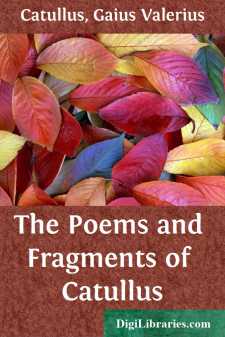Categories
- Antiques & Collectibles 13
- Architecture 36
- Art 48
- Bibles 22
- Biography & Autobiography 813
- Body, Mind & Spirit 141
- Business & Economics 28
- Children's Books 12
- Children's Fiction 9
- Computers 4
- Cooking 94
- Crafts & Hobbies 4
- Drama 346
- Education 46
- Family & Relationships 57
- Fiction 11826
- Games 19
- Gardening 17
- Health & Fitness 34
- History 1377
- House & Home 1
- Humor 147
- Juvenile Fiction 1873
- Juvenile Nonfiction 202
- Language Arts & Disciplines 88
- Law 16
- Literary Collections 686
- Literary Criticism 179
- Mathematics 13
- Medical 41
- Music 40
- Nature 179
- Non-Classifiable 1768
- Performing Arts 7
- Periodicals 1453
- Philosophy 64
- Photography 2
- Poetry 896
- Political Science 203
- Psychology 42
- Reference 154
- Religion 513
- Science 126
- Self-Help 83
- Social Science 81
- Sports & Recreation 34
- Study Aids 3
- Technology & Engineering 59
- Transportation 23
- Travel 463
- True Crime 29
The Poems and Fragments of Catullus
Categories:
Description:
Excerpt
PREFACE.
The idea of translating Catullus in the original metres adopted by the poet himself was suggested to me many years ago by the admirable, though, in England, insufficiently known, version of Theodor Heyse (Berlin, 1855). My first attempts were modelled upon him, and were so unsuccessful that I dropt the idea for some time altogether. In 1868, the year following the publication of my larger critical edition of Catullus, I again took up the experiment, and translated into English glyconics the first Hymenaeal, Collis o Heliconici. Tennyson's Alcaics and Hendecasyllables had appeared in the interval, and had suggested to me the new principle on which I was to go to work. It was not sufficient to reproduce the ancient metres, unless the ancient quantity was reproduced also. Almost all the modern writers of classical metre had contented themselves with making an accented syllable long, an unaccented short; the most familiar specimens of hexameter, Longfellow's Evangeline and Clough's Bothie of Tober-na-Vuolich and Amours de Voyage were written on this principle, and, as a rule, stopped there. They almost invariably disregarded position, perhaps the most important element of quantity. In the first line of Evangeline—
This is the forest primeval, the murmuring pines and the hemlocks,there are no less than five violations of position, to say nothing of the shortening of a syllable so distinctly long as the i in primeval. Mr. Swinburne, in his Sapphics and Hendecasyllables, while writing on a manifestly artistic conception of those metres, and, in my judgment, proving their possibility for modern purposes by the superior rhythmical effect which a classically trained ear enabled him to make in handling them, neglects position as a rule, though his nice sense of metre leads him at times to observe it, and uniformly rejects any approach to the harsh combinations indulged in by other writers. The nearest approach to quantitative hexameters with which I am acquainted in modern English writers is the Andromeda of Mr. Kingsley, a poem which has produced little effect, but is interesting as a step to what may fairly be called a new development of the metre. For the experiments of the Elizabethan writers, Sir Philip Sidney and others, by that strange perversity which so often dominates literature, were as decidedly unsuccessful from an accentual, as the modern experiments from a quantitative point of view. Sir Philip Sidney has given in his Arcadia specimens of hexameters, elegiacs, sapphics, asclepiads, anacreontics, hendecasyllables. The following elegiacs will serve as a sample.
Unto a caitif wretch, whom long affliction holdeth,And now fully believ's help to bee quite perished;
Grant yet, grant yet a look, to the last moment of his anguish,
O you (alas so I finde) caus of his onely ruine:
Dread not awhit (O goodly cruel) that pitie may enter
Into thy heart by the sight of this Epistle I send:
And so refuse to behold of these strange wounds the recitall,
Lest it might m' allure home to thyself to return....


